About Us at The Wild Vines
We started our vineyard in the Fall of 2006 with ground prep and the ordering our first vines. We selected a test plot with twenty-one different varieties for use in wine, juice and table. We ordered our vines with the plan to have them shipped and received the first week of April. In preparing the vineyard we erected a deer fence around the entire parameter to help keep any and hopefully all ground based predators out. From ground surface to top is seven and a half feet of fence that is almost invisible till you get up close. Groundwork was prepped by tilling the rows with compost and spraying herbicide to help control any encroaching grass and weeds
.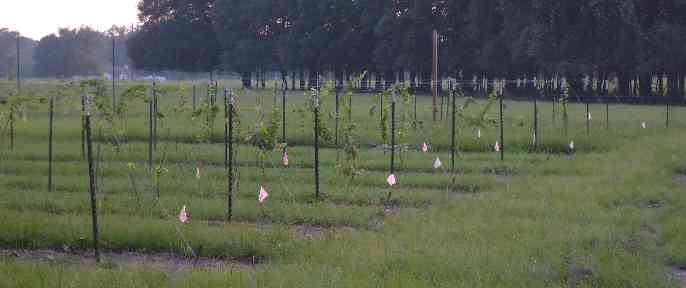
Spring 2007 Planting (April)
All vines arrived as expected and in good health. Our last day of frost was done, we had a surprise frost the first week of April, but we had to unexpectedly delay planting due to some equipment that had not arrived on time.
All vines ordered were first year with well formed roots. We used an auger to drill out twenty four to thirty inch holes, deep into the ground. We added rich manure compost in the bottom two to three inches with a shallow layer of the removed earth. After vines were planted, staked and watered it was time to run the irrigation. We used a temporary drip system until the second phase, in 2008, was planted and trellis system was up and ready.
With our first test plots in the ground it was time to run the trellis system and start training them early to the type of system they need. It was amazing how well the vines were growing. It seemed they were pushing us to get the trellis done. With the trellises in place and the vines doing very well, all left was to train and manicure.
On 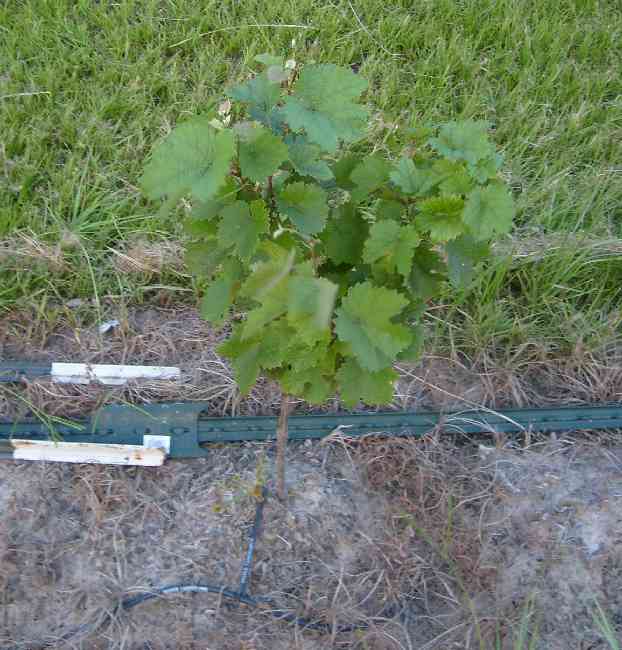 our first year vines we pinched off all
the flowerets that formed to prevent any fruit development. This helped to encourage the root growth
and vine growth.
our first year vines we pinched off all
the flowerets that formed to prevent any fruit development. This helped to encourage the root growth
and vine growth.
Throughout the growing season we monitored growth and susceptibility to the Texas climate, weather conditions, and the good old pests. Our site was a very good selection as we get an almost constant breeze from the south and that helps dry times on the leaves. Protection on our eastern side is provided by a dense wooded area also helping to channel the air flow from the south straight through the vineyard. The northern boundary is lined with a thin row of trees to protect in the winters from northern breezes and help reduce frost damage.
By the end of the year, in late Fall we did our final measurements and gathered data to finalize planning for 2008 plantings.
Multi-use and Table Varieties for 2008
For our multi-use and table varieties we selected four to plant; these will be sold locally for eating or turning into jams.
Vanessa
is a red seedless table grape. Brianna is a seeded white, but very sweet,
grape for jams or juice and possible white wine. Sunbelt is a Concord variety that is very vigorous and ripens early,
holds up well against the Texas heavy rains and heat, and is a good
multipurpose grape for table, jam or wine. Caco is a vigorous red variety that handles our hot
summer and is excellent for jams, juices and eating. 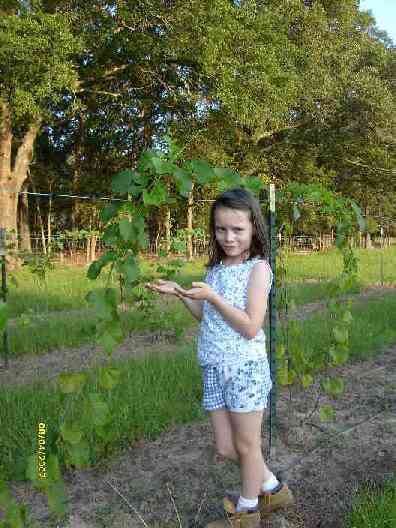
Wine Varieties for 2008
For our wine producing varieties we selected four to be planted. This will be the second stage of the test plots. Although all vines did very well in their first year, these four did exceptionally well and have a commercial need in the wine market of Texas.
Our first selection was Petite Syrah and it did the best in overall growth and canopy formation of all the first year wine varieties. Petite Syrah produces high quality wines of deep red color and lusty character.
Our second variety was Villard Blanc which is Pierce's Disease resistant and needs a longer growing season and in Texas we have both. Villard Blanc produces a fruity, mildly intense white wine (somewhat Sauvignon Blanc like) of fairly neutral and simple flavors.
The third variety is from the Gewurztraminer family white wine grape that is spicy and makes for a good sugar/PH/acid blend of a wine, my favorite. This variety of Gewurztraminer clone is suited for warmer climates unlike it parent variety.
Last variety grown is Prairie Star, a blending white variety that adds good mouth feel, finish, with a hint of a floral nose to a thinner wine variety. Also very good to eat right off the vine as will be mentioned later on this page.
We also have a fifth variety that we are planting along our western side as a buffer to help protect from wind and pest from adjoining properties. It is a red variety that is very disease resistant and if picked early it can make a high acid, medium bodied red wine with good tanning similar to a Baco Noir. It produces a deep red color, and, if allowed to fully ripened in longer growing season, can be quite aromatic in character. It also makes for a good blending red wine when needing more acid or mixed with higher sugar wines to add some spice.
We
started into the next planting 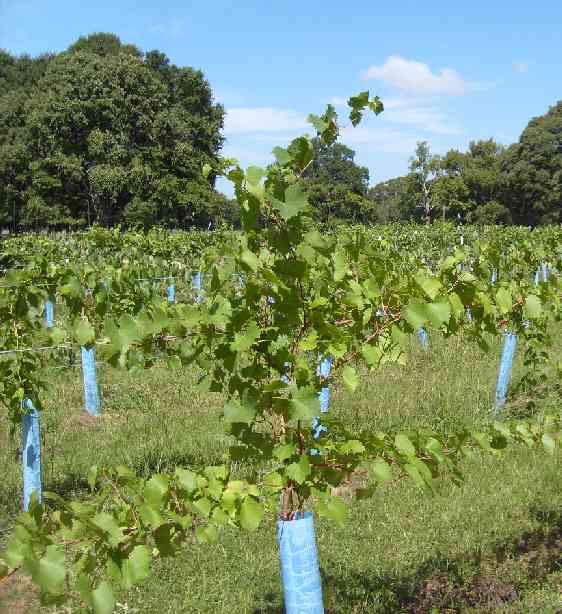 season as we did in 2007 as we tilled
and sprayed rows in preparation for the new plantings in the Fall.
We also continued to monitor growth on both new (2008) plantings as well
as our last years vines, all twenty one varieties. Our first
year vines, now in to year two, were allowed to produce fruit.
Harvested grapes ranged from a low 2.3lbs. to a nice 3.8lbs. per
vine. Did I say second year vines, wow. So far they are all
loving our deep sandy loam soil and higher temperatures. Thank
God! We hand harvested and pressed the grapes, fermenting in small
batches to get a
feel of quality for various wines. Even being a young vine they were
producing grapes with Brix of 19 to 22. Well as they say "Everything
is bigger in Texas", that must go for vine growth and production.
season as we did in 2007 as we tilled
and sprayed rows in preparation for the new plantings in the Fall.
We also continued to monitor growth on both new (2008) plantings as well
as our last years vines, all twenty one varieties. Our first
year vines, now in to year two, were allowed to produce fruit.
Harvested grapes ranged from a low 2.3lbs. to a nice 3.8lbs. per
vine. Did I say second year vines, wow. So far they are all
loving our deep sandy loam soil and higher temperatures. Thank
God! We hand harvested and pressed the grapes, fermenting in small
batches to get a
feel of quality for various wines. Even being a young vine they were
producing grapes with Brix of 19 to 22. Well as they say "Everything
is bigger in Texas", that must go for vine growth and production.
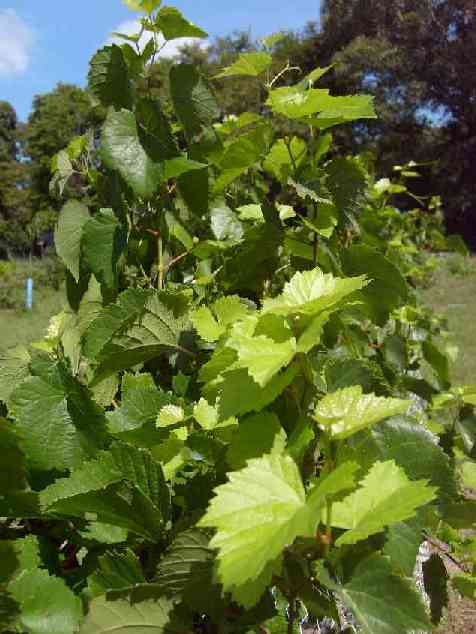 We allowed some grapes to hang on the vines longer to see if we could get
a higher Brix but each stayed at there harvested numbers. We
are very pleased with the 2007 plantings growth and production as well as with the
new 2008 planting.
We are considering adding one more wine variety, chambourcin, to our test
groups as the ones planted in 2007 have produced quite well and the
quality was great. If we find a commercial buyer it may get
added. Chambourcin produces a ruby-colored wine that has a
reasonably full, slightly herbaceous flavor and aroma. This grape is
listed both as a Rosť
and a red wine.
We allowed some grapes to hang on the vines longer to see if we could get
a higher Brix but each stayed at there harvested numbers. We
are very pleased with the 2007 plantings growth and production as well as with the
new 2008 planting.
We are considering adding one more wine variety, chambourcin, to our test
groups as the ones planted in 2007 have produced quite well and the
quality was great. If we find a commercial buyer it may get
added. Chambourcin produces a ruby-colored wine that has a
reasonably full, slightly herbaceous flavor and aroma. This grape is
listed both as a Rosť
and a red wine.
A Little Bite of an Organic Approach
Some additions we have made to our growing 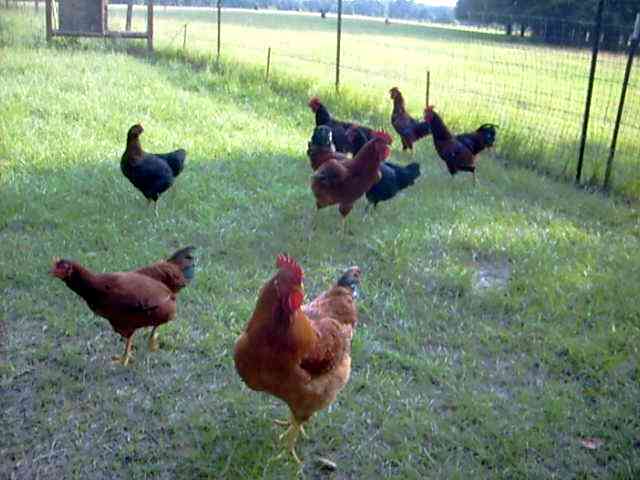 practices in 2008 are adding
chickens to the vineyard. A very cheap pest control product,
it has reduced the expense on chemical pesticide spraying to almost
nil. The chickens also have helped with weeding the rows.
They will scratch at the new young weeds and eat the fresh buds along with
any seed heads that will come later. Our herbicide spraying is
greatly reduced and the extra fertilizers they leave behind, well . .
. its full
of everything a growing vine needs. Oh did I mention free
eggs... We have a total of nineteen, seven males and twelve females. Each female has the potential to lay one egg a day.
The chicken house is designed to house up to one hundred birds. I
don't plan on having that many but as the vineyard grows also the
invitation grows for pest to come to dinner. Just want to make sure
they are coming as dinner for the chickens and not dinner on the
vines.
practices in 2008 are adding
chickens to the vineyard. A very cheap pest control product,
it has reduced the expense on chemical pesticide spraying to almost
nil. The chickens also have helped with weeding the rows.
They will scratch at the new young weeds and eat the fresh buds along with
any seed heads that will come later. Our herbicide spraying is
greatly reduced and the extra fertilizers they leave behind, well . .
. its full
of everything a growing vine needs. Oh did I mention free
eggs... We have a total of nineteen, seven males and twelve females. Each female has the potential to lay one egg a day.
The chicken house is designed to house up to one hundred birds. I
don't plan on having that many but as the vineyard grows also the
invitation grows for pest to come to dinner. Just want to make sure
they are coming as dinner for the chickens and not dinner on the
vines.
On
a side note if you do plan to add chickens to your pest management
plans please know that the chickens will also be a good monitor to tell
when you grapes are approaching ripeness. Yes you guessed
it... 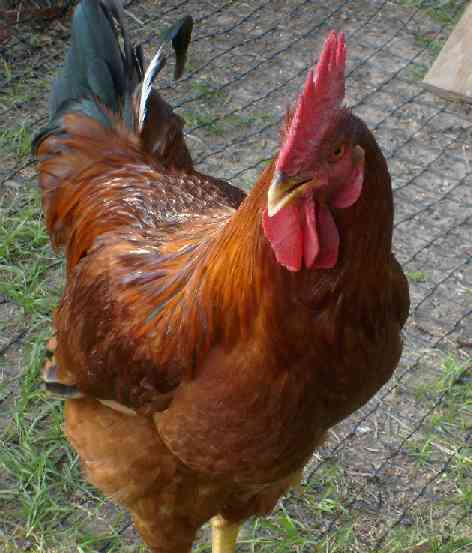 They love grapes... I went out to measure Brix on the
Prairie Star as they are an early ripening variety, well the Brix was at
20, but what would have been about 3lbs. per vine of a harvest,
turned out to be just enough to calculate that the Brix was 20....
They love grapes... I went out to measure Brix on the
Prairie Star as they are an early ripening variety, well the Brix was at
20, but what would have been about 3lbs. per vine of a harvest,
turned out to be just enough to calculate that the Brix was 20....
I will say it was quite funny watching the little guys hopping up snatching bugs off the vines and then realizing that they were actually hopping to snatch off the grapes and not bugs. Can't blame them. The Prairie Star grapes, I think, are the best tasting right off the vines, with kind of a strawberry-pear flavor. We will have to wait till next year to see what we can get from the vines.
To address this issue of the fruit ripening on the vine and chickens drooling over them we installed a system like an upside-down umbrella made out of 36" wide poultry wire down both sides, just below the fruiting wire. It is bowed out at the bottom and left open at the top and uses a support wire holding the shape to the top wire on the trellis. This worked perfectly to keep them from accessing the fruit and also deterred other wild life from also coming to dinner. At harvest time we just unhooked from the top wire and let hang. I could have used bird netting but poultry wire can be left up and should last longer.
We still have the issue of cutworms but with the reduction of spraying pesticides, the spider population is up and they seem to handle them pretty well Some spot spraying is then used for minor outbreaks.
Aphids, Mites and disease is all that is left and they can be handled with organic pesticides and fungicides along with predators that will be allowed to thrive in larger numbers without harmful pesticides doing them in too.
In
the first year 2007, we also added goats, Boer goats, to the eastern wooded area to
control weeds and unwanted 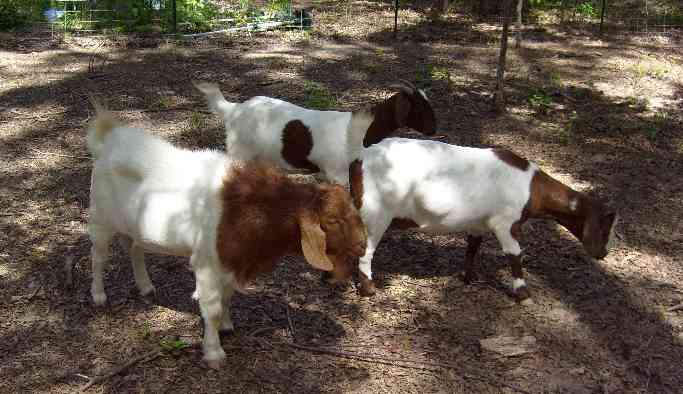 wild vines from growing too near the
vineyard. They are good cheap labor also as they have cleared out
everything five feet and below. When fall pruning is done
they can eat the cuttings and the by product is fertilizer. We are only using three goats, two females and one male. I think
more will happen naturally but that is going to have to be for them to
decide.
wild vines from growing too near the
vineyard. They are good cheap labor also as they have cleared out
everything five feet and below. When fall pruning is done
they can eat the cuttings and the by product is fertilizer. We are only using three goats, two females and one male. I think
more will happen naturally but that is going to have to be for them to
decide.
